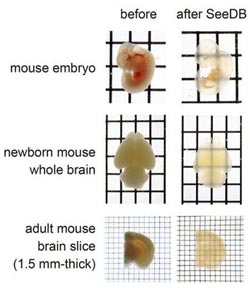Sugar solution makes tissues see-through

Japanese researchers have developed a new sugar and water-based solution called SeeDB that turns tissues transparent in just three days, without disrupting the shape and chemical nature of the samples. Combined with fluorescence microscopy, this technique enabled them to obtain detailed images of a mouse brain at an unprecedented resolution.<br><br>Credit: RIKEN<br>
The team from the RIKEN Center for Developmental biology reports their finding today in Nature Neuroscience.
Over the past few years, teams in the USA and Japan have reported a number of techniques to make biological samples transparent, that have enabled researchers to look deep down into biological structures like the brain.
“However, these clearing techniques have limitations because they induce chemical and morphological damage to the sample and require time-consuming procedures,” explains Dr. Takeshi Imai, who led the study.
SeeDB, an aqueous fructose solution that Dr. Imai developed with colleagues Drs. Meng-Tsen Ke and Satoshi Fujimoto, overcomes these limitations.
Using SeeDB, the researchers were able to make mouse embryos and brains transparent in just three days, without damaging the fine structures of the samples, or the fluorescent dyes they had injected in them.
They could then visualize the neuronal circuitry inside a mouse brain, at the whole-brain scale, under a customized fluorescence microscope without making mechanical sections through the brain.
They describe the detailed wiring patterns of commissural fibers connecting the right and left hemispheres of the cerebral cortex, in three dimensions, for the first time.
Dr. Imai and colleagues report that they were also able to visualize in three dimensions the wiring of mitral cells in the olfactory bulb, which is involved the detection of smells, at single-fiber resolution.
“Because SeeDB is inexpensive, quick, easy and safe to use, and requires no special equipment, it will prove useful for a broad range of studies, including the study of neuronal circuits in human samples,” explain the authors.
Dr. Takeshi Imai is available for interviews over the phone at +81(0) 78-306-3376 or by email at imai@cdb.riken.jp.
Alternatively, for more information please contact:
Juliette Savin
Global Relations Office
RIKEN
Tel: +81-(0)48-462-1225
Mobile phone: +81-(0)808895-2136
Email: pr@riken.jp
Pictures and the original journal research article in Nature Neuroscience are available on request.
Reference
Meng-Tsen Ke, Satoshi Fujimoto, and Takeshi Imai
“SeeDB: a simple and morphology-preserving optical clearing agent for neuronal circuit reconstruction”
Nature Neuroscience, 2013 doi: 10.1038/nn.3447
About RIKEN
RIKEN is Japan's largest research institute for basic and applied research. Over 2500 papers by RIKEN researchers are published every year in leading scientific and technical journals, covering a broad spectrum of disciplines including physics, chemistry, biology, medical science and engineering. RIKEN's research environment and strong emphasis on interdisciplinary collaboration and globalization has earned a reputation for scientific excellence worldwide.
Website: http://www.riken.jp/en/ Find us on Twitter at @riken_en
About the Center for Developmental Biology
The RIKEN Center for Developmental Biology (CDB) was launched in April 2000 to advance research in the fields of animal development and regeneration and contribute to areas of clinical medicine that can benefit from such research. The CDB is dedicated to developing a better understanding of fundamental processes of animal development at the molecular and cell biological level, the more complex phenomena involved in organogenesis as well as the biology of stem cells and regeneration. By elucidating these processes researchers working at CDB hope to improve the effectiveness of regenerative medicine, for the benefit of society.
Media Contact
All latest news from the category: Life Sciences and Chemistry
Articles and reports from the Life Sciences and chemistry area deal with applied and basic research into modern biology, chemistry and human medicine.
Valuable information can be found on a range of life sciences fields including bacteriology, biochemistry, bionics, bioinformatics, biophysics, biotechnology, genetics, geobotany, human biology, marine biology, microbiology, molecular biology, cellular biology, zoology, bioinorganic chemistry, microchemistry and environmental chemistry.
Newest articles

High-energy-density aqueous battery based on halogen multi-electron transfer
Traditional non-aqueous lithium-ion batteries have a high energy density, but their safety is compromised due to the flammable organic electrolytes they utilize. Aqueous batteries use water as the solvent for…

First-ever combined heart pump and pig kidney transplant
…gives new hope to patient with terminal illness. Surgeons at NYU Langone Health performed the first-ever combined mechanical heart pump and gene-edited pig kidney transplant surgery in a 54-year-old woman…

Biophysics: Testing how well biomarkers work
LMU researchers have developed a method to determine how reliably target proteins can be labeled using super-resolution fluorescence microscopy. Modern microscopy techniques make it possible to examine the inner workings…





















